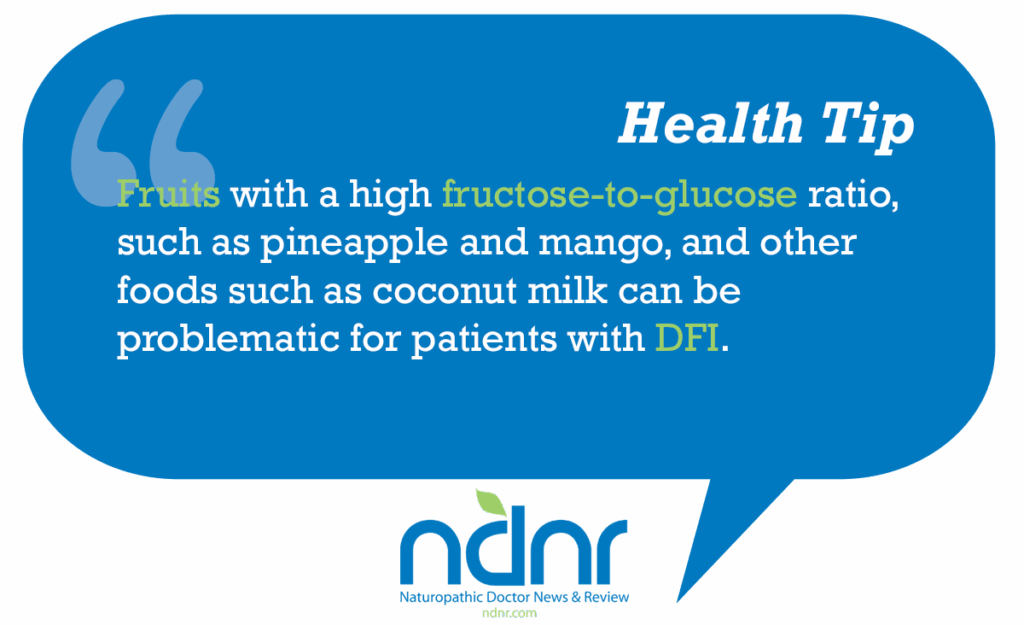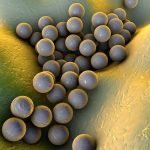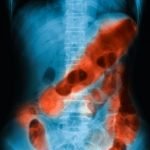Dietary Fructose Intolerance: A Diagnosis Masked Behind IBS?
EeVon Ling, ND
Diarrhea, nausea, bloating, abdominal pain and cramping – when a patient suffering with these symptoms has been diagnosed with irritable bowel syndrome (IBS) and eventually comes to see you as the ND, the first approach that commonly comes to mind may be to eliminate all dairy and wheat (and perhaps gluten) from this person’s diet. When this doesn’t improve the situation significantly, then other nutritional interventions must be considered. The elimination of fructose from the diet should be one of them.
Dietary fructose intolerance (DFI), or fructose malabsorption, is the inability to absorb free fructose efficiently or completely by the enterocytes of the small intestine. Due to the nature of fructose absorption (as will be discussed), this condition likely affects a significant percentage of the general population, from children to adults. DFI should not be confused with hereditary fructose intolerance, a life-threatening disorder of fructose metabolism due to a deficiency of aldolase-B.
 Fructose is a monosaccharide carbohydrate most commonly found in fruit, vegetables and commercial sweeteners such as high fructose corn syrup. Fructan, a polymer of fructose molecules, is found in vegetables, fruit and wheat. Fructan forms soluble fibers such as inulin and fructo-oligosaccharide. Other sources of fructose are sucrose, which is comprised of one molecule each of glucose and fructose, and sorbitol, a sugar alcohol that is converted into fructose during digestion. Fructose as a sweetener is frequently used in the food industry due to its higher relative sweetness, earlier perceived sweetness, longer shelf stability, better moisture retention and lower cost. And although fructose may not contribute more than 10% of the total calories of the average North American diet, its presence in food is ever increasing. There has been a sharp rise in the use of fructose in foods over the last three decades, especially in the form of high fructose corn syrup. High fructose corn syrup is prevalent in many everyday foods, such as: beverages (alcoholic coolers, flavored water, fruit cocktails, soft drinks, sports drinks, etc.), candies and dessert, baked goods, sauces, flavored yogurt, table syrup, sweetened cereals, granola cereals and granola bars.
Fructose is a monosaccharide carbohydrate most commonly found in fruit, vegetables and commercial sweeteners such as high fructose corn syrup. Fructan, a polymer of fructose molecules, is found in vegetables, fruit and wheat. Fructan forms soluble fibers such as inulin and fructo-oligosaccharide. Other sources of fructose are sucrose, which is comprised of one molecule each of glucose and fructose, and sorbitol, a sugar alcohol that is converted into fructose during digestion. Fructose as a sweetener is frequently used in the food industry due to its higher relative sweetness, earlier perceived sweetness, longer shelf stability, better moisture retention and lower cost. And although fructose may not contribute more than 10% of the total calories of the average North American diet, its presence in food is ever increasing. There has been a sharp rise in the use of fructose in foods over the last three decades, especially in the form of high fructose corn syrup. High fructose corn syrup is prevalent in many everyday foods, such as: beverages (alcoholic coolers, flavored water, fruit cocktails, soft drinks, sports drinks, etc.), candies and dessert, baked goods, sauces, flavored yogurt, table syrup, sweetened cereals, granola cereals and granola bars.
Fructose Absorption Process
Although fructose is a simple sugar, its absorption in the digestive tract is quite complex. During normal digestion, the fructose is absorbed in the small intestine by two carrier proteins. Fructose is first transported from the lumen of the small intestine into the enterocyte via a low-capacity facilitated diffusion GLUT5 protein. The fructose is then transported out of the enterocyte into the apical membrane via the more rapid glucose activated GLUT2 protein. Compared to glucose, the absorption of fructose is much slower and not as complete. However, the absorption rate of fructose can range greatly depending on different dietary and individual physiological factors. Fructose absorption is greatest when it is in equal quantities with glucose in the intestine, such as occurs with sucrose ingestion. Increasing one’s dietary fructose intake can also influence absorption rates by the up regulation of the GLUT5 protein. A high fructose diet can increase the number of transport proteins within days.
Any fructose not absorbed is transported to the large intestine and broken down by the colonic microflora into short chain fatty acids, carbon dioxide, methane and hydrogen. There is a wide variance of absorptive capacity of free fructose among populations, from very poor to efficient, and it is not well understood why such differences exist. A person with DFI indeed has a limited fructose absorption rate, perhaps due to impaired GLUT5 activity, and so increased amounts of fructose pass into the large intestine. Increased fructose in the large intestine increases the osmotic load and fuel for bacterial fermentation, resulting in altered gastrointestinal motility, altered microfloral populations and decreased nutrient absorption. In fact, the long-term consequence of suffering from DFI can be low plasma folic acid concentrations, and low serum tryptophan and zinc. In addition to these nutrient deficiencies, DFI can also produce elevated serum amylase and lipase concentration; elevated plasma and liver triglycerides; and lower vitamin C, vitamin E and glutathione activities. Aside from the physical symptoms of DFI, these associated biochemical alterations can have other clinical and health implications, such as mental depression. And yet, DFI may go unrecognized because the attention paid to lactose and gluten intolerance may overshadow its consideration and diagnosis. To diagnose DFI, a hydrogen breath test is performed against a fructose challenge. Studies have shown this test to be 95-98% sensitive and specific.
While it is not known whether DFI can be cured or resolved, dietary interventions can help alleviate symptoms and prevent nutrient deficiencies. Avoiding foods that are high in fructose and have a low fructose-to-glucose ratio may help. Interestingly, most fruits and vegetables in their natural state have equal amounts of glucose to fructose, providing a relatively low fructose load when eaten in reasonable amounts. However, processed foods can greatly increase the total fructose load and create problems for those with DFI, even if the fructose level is equal to the glucose level (as in high fructose corn syrup and fruit juices). Box 1 provides a list of foods that can be problematic for those with DFI.
Digestive issues may be one of the most common complaints that brings patients to both allopathic medical doctors and NDs alike. If a significant number of these individuals are simply diagnosed with IBS, the ND will have a larger role in determining cause and treatment to bring about relief and a return to health. However, with the high attention paid to lactose and gluten intolerance, DFI may be overlooked. It is proposed that perhaps many of the cases of unexplained digestive conditions, from pediatric diarrhea to the ubiquitous IBS, are in fact DFI. Also, because the use of fructose as a sweetener is increasing in the food industry, early recognition of DFI may help prevent a lifetime of health problems.
 EeVon Ling graduated from CCNM and currently has a general practice in the heart of downtown Toronto. She is also a certified hypnotherapist and uses this modality to complement her practice.
EeVon Ling graduated from CCNM and currently has a general practice in the heart of downtown Toronto. She is also a certified hypnotherapist and uses this modality to complement her practice.
References
Groff JL, Gropper SS: Advanced Nutrition and Human Metabolism (3rd ed). Belmont, 2000, Wadsworth Thomson Learning, pp. 73-78.
Calorie Control Council: www.fructose.org
Gouyon F et al: Simple-sugar meals target GLUT2 at enterocyte apical membranes to improve sugar absorption: a study in GLUT2-null mice, Journal of Physiology Nov 1;552(Pt 3):823-32, 2003.
Ledochowski M et al: Increased serum amylase and lipase in fructose malabsorbers, Clin Chim Acta Sep 25;311(2):119-23, 2001.
Ledochowski M et al: Fructose malabsorption is associated with early signs of mental depression, European Journal of Medical Research 3:295-298, 1998.
Nutrition Data: www.nutritiondata.com/tools/nutrient-search









